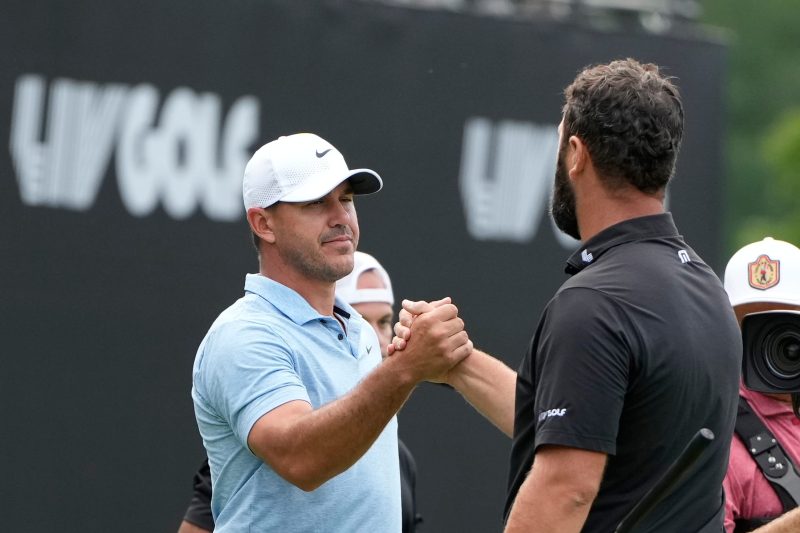AUGUSTA, Ga. – Every year since the world could see the place on television, this little town near the border of Georgia and South Carolina has been the epicenter of our retreat out of a long winter and into spring.
That’s always been the secret sauce of the Masters. Not the exclusivity of the club, nor the difficulty of the course, nor really the fact that it’s the only major championship in golf anchored to one place every year.
Mostly, it’s the visuals, the colors, perfectly green fairways framed by the towering pines and flowers that pop off the television screen like an invitation to once again start going outside. As always, every inch of this place is spectacular.
“A colder-than-normal January has been conducive to a near-perfect early spring bloom of Azaleas and other flowering ornamentals,” Augusta National chairman Fred Ridley said Wednesday. “One of our guests last week referred to the course as a beautiful painting, and I could not agree more.”
But the biggest golf tournament in the world has only grown in prestige over the past four years – not that it needed any help. The still unresolved fight between the PGA Tour and LIV, still simmering for a third straight Masters, has only made this tournament more powerful and elevated its place atop the sport’s food chain.
The sad reality is that it’s been nine months since Xander Schauffele won the Open Championship at Royal Troon. That’s nine months since all the best players in the world were in the same tournament. Nine months since we saw Rory McIlroy go against Brooks Koepka in a significant event, nine months since Scottie Scheffler has had a chance to close out a tournament with Bryson DeChambeau breathing down his neck.
Nearly two years since the so-called framework agreement that was supposed to bring the two sides into some type of merger agreement and almost three months since president Donald Trump’s inauguration – an event that inspired hope of reconciliation given his ties to the game and extensive business with the Saudi government – everyone is still waiting.
“I think at some point if the players get all together, I think we could figure it out,” DeChambeau said. “But it’s a lot more complicated, obviously, than we all think.”
At this point, it’s almost boring to talk about. LIV does its thing, paying huge sums to Jon Rahm, Phil Mickelson and a handful of others to play unserious golf while drawing pathetic television audiences. (Even on the main FOX network last week, LIV Miami drew less than one-third of the 1.746 million viewers watching the final round of the Valero Texas Open.)
But LIV’s intrusion into the sport has undeniably made the PGA Tour a significantly lesser product, too, and not just on the margins. The Tour’s so-called “Signature Event” structure, in which eight tournaments are elevated above the others, means the top players have even less incentive to play a full schedule and so there are rarely fields packed with stars – a split within a split. Aside from The Players, has there even been a single must-see tournament yet this year?
That’s golf now: Weaker, less interesting, rarely relevant to the average sports fan outside of the four majors. Round and round we go, with little to suggest a solution is coming that would reunite the best players and give fans – not to mention the companies paying huge sums to sponsor most of these tournaments – a reason to keep spending their cash on professional golf.
“When I think about reunification,” Ridley said, “I think about the having more players – all of the great players of the game – playing against each other more than just a few times a year. I’m not really in a position to say what form that should take as far as how the two organizations should come together, what legal structure that may be or what the financial aspects of that may be. But sometimes if you start kind of at eye level, and that is to encourage cooperation and trying to figure out a way to get something done, regardless of what the structure of it is, to where everyone can play together again.”
For the broader good of the game, Ridley is of course correct.
But as long as the split endures, the Masters benefits more than anyone.
Why? Well, most golf fans could probably tell you that McIlroy comes into the Masters with as good of a chance as he’s ever had, having won twice already this year including The Players. They could probably tell you how Scheffler, the defending champion here and No. 1 player in the world, has been struggling by his standards but flashed a hot putter last weekend that makes him extra dangerous this week. And they could probably tell you that Schauffele, who won two majors last year, has been way off form to start this season and is yet to record a top-10 finish.
And the LIV guys? When the final major championship ends in July, they simply disappear into the ether. Yes, they are playing tournaments. Some of those tournaments even draw good crowds, particularly in an Australian market that deserves more world class golf than it gets. But if you know a single thing about how Patrick Reed, Rahm, Koepka, Dustin Johnson, Cam Smith and the rest have been faring lately on the LIV tour, you are in the minority of the minority of golf fans.
Now in its fourth season, there’s enough of a sample size to make the following statement: Whatever you think about the concept of LIV or who’s paying its bills, the results over there simply do not matter to very many people. Nothing has broken through. Nobody’s really watching
In fact, in four years, you can argue the only player-related LIV storyline that has been elevated to any relevance is a highly online argument between real people and social media trolls over whether four-time LIV winner Joaquin Niemann is one of the top-10 players in the world. (Given that he’s never finished better than 16th at any major, I think we all know the answer to that one.)
Point being, for all the significant players who took the LIV payday, the Masters is when they come out of the mothballs. Has Koepka or Rahm played well lately? Who knows. Who cares. When Masters week begins, it’s like reuniting with a friend who spent the last year in western Mongolia without Internet or cell phone service. We’re just happy to see them again.
“When you look back at whenever LIV started and this whole debacle started, no one really complained,” Collin Morikawa said. “You just…we enjoyed it. But then this all happened, and you take things for granted. You look back and you’re like, man, we had it pretty good. These weeks are special now. You don’t take them lightly.”
Make no mistake, the Masters is a colossus whether LIV exists or not. To golfers and hardcore fans, it’s special because it’s a major. To the common sports viewer who watches this tournament and maybe a few others, it’s the visual effects – the sparkling white sand, the vividly pink flowers, the perfectly mowed grass − that inspire imagination and awe.
But the PGA Tour-LIV split has made this week something different, even a level above what the Masters was before. Golf fans just don’t get many tournaments like this anymore. That’s a sad commentary on the state of the game but another layer of mystique for a 365-acre tract of Georgia land that was already the biggest thing in the sport.

